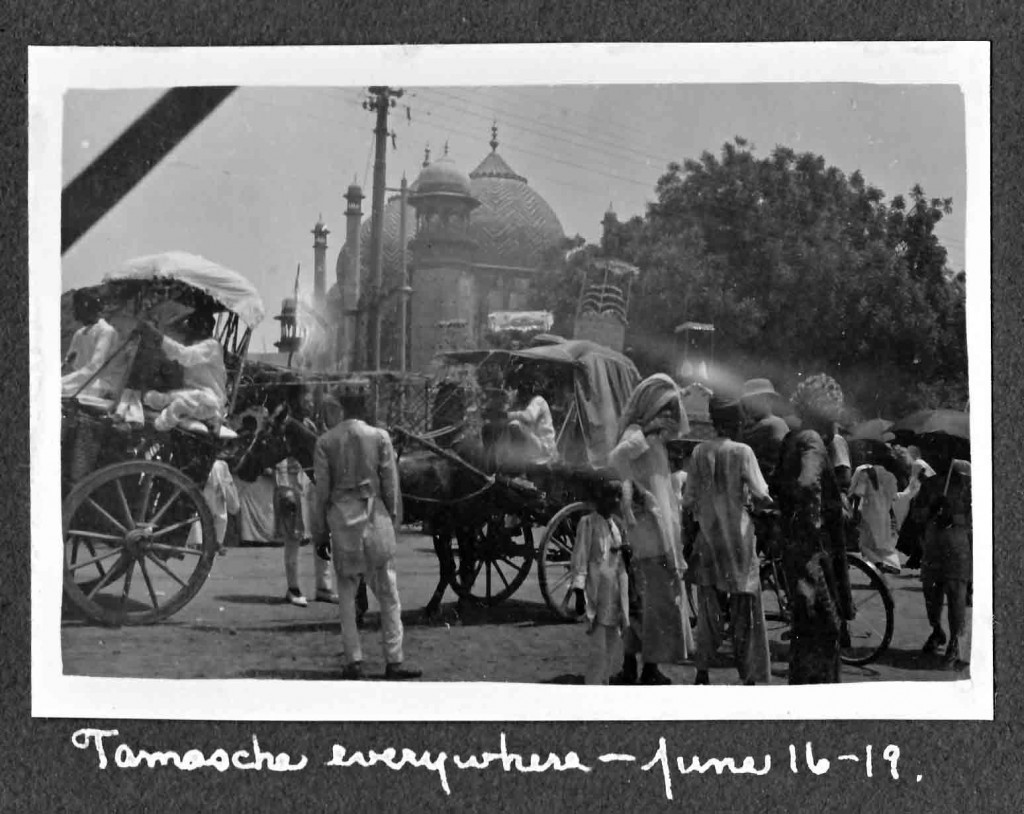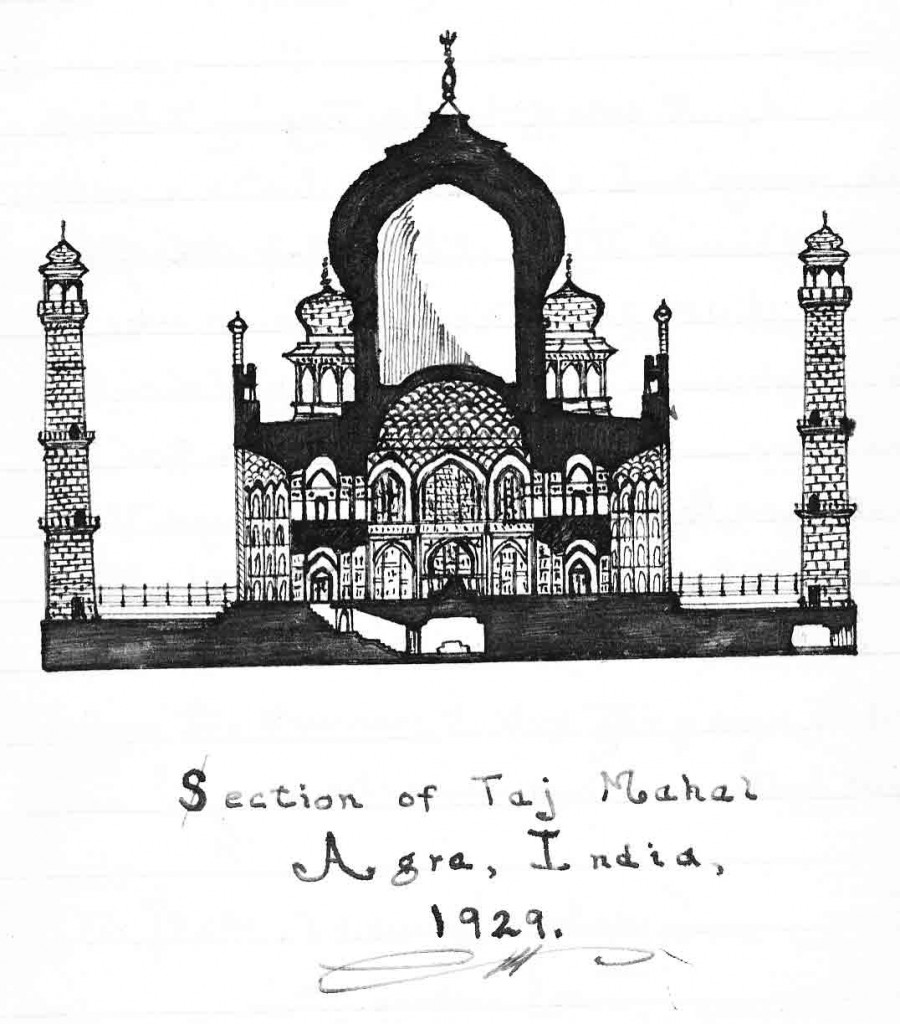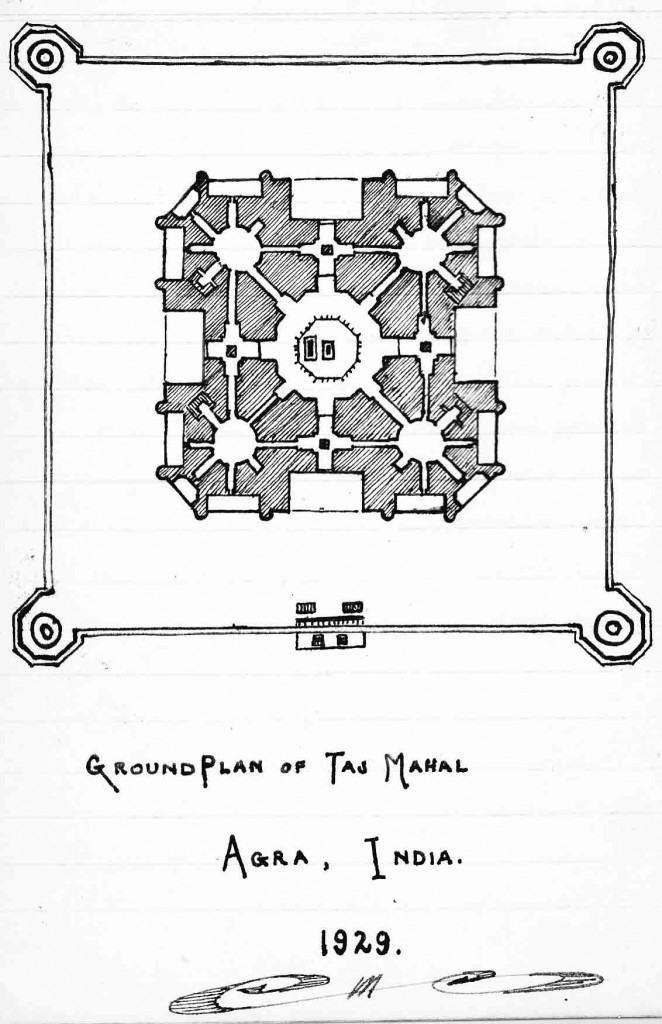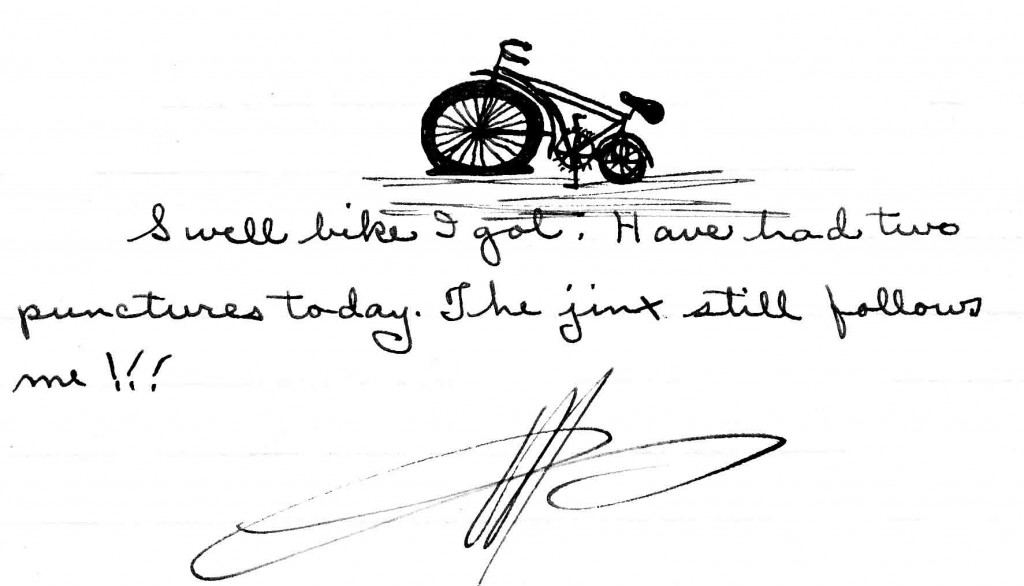Sunday, June 16, 1929
The Eurasian (?) woman who runs the hotel (Scottish husband) tried to sell us on a tonga for the week, or bikes at a rupee a day. She is a clever cuss. We insisted on getting our own bikes, and did so for 6 annas a day, blowing has ideas of a fat 75¢ profit a day for herself—at our expense. Spent all morning finding a place to have our 40-odd rolls of pictures developed. We are sampling two places now, but it looks as though it will have to go to the most expensive one for reliability and good work.
The weather continues slightly misty—not much, but enough to keep the sun from becoming too hot. Couldn’t have been over 108° today. However, we stayed indoors till after three. A servant at the hotel here had a sunstroke last week, by noon he had a fever and died that evening.
We visited the Taj Mahal this afternoon. Following the Mall Road from the hotel we soon angled off to the left and passed MacDonnell Park on the left. The approach to the Taj, flanked by the tomb and the Fatehpuri Mosque of red sandstone, forms an extremely picturesque scene.
 I have no desire to even try to find words with which to describe the Taj. There are none. It is simply the most exquisite building I have ever seen, perfect in every way, delicately beautiful, full of charm and romance—”a poem in marble”—but I am doing what I said I wouldn’t. Its fascination grows on you and no matter in which direction you walk, you unconsciously turn your head toward this world wonder.
I have no desire to even try to find words with which to describe the Taj. There are none. It is simply the most exquisite building I have ever seen, perfect in every way, delicately beautiful, full of charm and romance—”a poem in marble”—but I am doing what I said I wouldn’t. Its fascination grows on you and no matter in which direction you walk, you unconsciously turn your head toward this world wonder.
Today is a Mohammedan holiday and hundreds were at the Taj. This colorful throng was a real sight from the minarets or from the gardens. But somehow throngs of people do not fit in with the quiet graceful beauty of the Taj.
Thus, tonight when we again visited the place, it had a far more irresistible charm. A barely misty half moon shone down upon the gardens, fountains, and the pure white marble domes and minarets of the Taj itself. Never was a scene more exquisite. Of course, we would have to have a picture so set up cameras for an hour time exposure. Then took off my shoes to play Halliburton in the lily pool. I was listening for the hoot of an owl when Frank pushed me in. It was only chest deep and the water was great. Got all messed up with lilies and everything else. But the only catch came in the form of some sharp rocks on the bottom. I picked out two or three nice ones to light on, and slashed a nasty gash in my big toe together with a few smaller digs. The darned thing bled so profusely I had to take it home on the bike. Guess I got one on Halliburton after all—even if the owl’s hoot was replaced by He Man’s Tulsa he-haw.
The approach to the Taj is by the Taj Ganj Gate, which opens into an outer court 880 feet long and 440 feet wide. Inside the court are two tombs raised on an upper storey in the SW and SE corners, and in the NW and NE corners are two enclosures, all of which have been satisfactorily repaired. On the right is a gate that leads into the quarter south of the Taj, where are proportions of original serai erected by Shah Jahan. On the left is the Great Gateway of the garden court, built in 1648, which has been called “a worthy pendant to the Taj itself.”
It is indeed a superb gateway of red sandstone, inlaid with ornaments and inscriptions from the Koran in white marble, and surmounted by twenty-six white marble cupolas.
Inside is the beautiful Taj garden. This is laid out in formal style, the whole to the south of the platform of the Taj and the buildings which support it, architecturally being divided by two main causeways into four portions, which are again subdivided into four. The principal vista is along a red sandstone watercourse, set between dual rows of dark green cypresses and interrupted in the middle by a marble platform. The Taj rises in all its peerless beauty at the end, and is mirrored in the water below. The trees of the garden, once too numerous and luxuriant, have been wisely thinned, and now admit of endless beautiful views and peeps of the marble dome, the marble walls, and the marble minarets, which can be enjoyed at leisure from the seats placed about the gardens. Along the south wall of the great gate is an extremely fine pillared gallery of red sandstone. The beauty of the Taj is perhaps most perfect immediately after sunset, or under the moonlight; but every change of light seems to lend new graces to it.
The central platform on which the tomb stands is 22 feet high and 133 feet square. At each corner is a minaret of white marble picked out by black lines, 137 feet high. The tomb itself measures 186 feet on each side, the corners being leveled off and recessed into a bay. On either side of each angle corner is another small bay and in the center of each side is a deeply recessed bay 63 feet high. The height of the walls and parapet over them is 108 feet; at each corner above them rise smaller marble domes, and in the center soars the great central dome, which rises to a height of 187 feet, the metal pinnacle adding yet 30 feet to the whole; the height of the top of the dome above the garden is just 25 feet less than that if the Ktub Minor, and the top of the pinnacle a few feet higher than that. “This building,” writes Mr. Ferguson in his “Indian Architecture,” is an exquisite example of that system of inlaying with precious stones which became the great characteristic of the style of the Mughals after the death of Akbar.” All the spandrels of the Taj, all the angles and more important details, are heightened by being inlaid with precious stones. These are combined with wreaths, scrolls, and frets, as beautiful in design as exquisite in color. They form the most beautiful and precious style of ornaments ever adopted in architecture. Though, of course, not to be compared with the beauty of Greek ornament, it surely stands first among the purely decorative forms of architectural design. The judgment with which this style of ornament is apportioned to the various parts is almost as remarkable as the ornament itself, and conveys a high idea of the taste and skill of the Indian architects of the age. The delicately sculptured ornamentation, in low relief, to be found on all exterior walls and the recesses of the building, is in its way as beautiful as the pietra dura work itself.
In the center of the tomb is an octagonal chamber surrounded by a series of other rooms. Each side of the central room measures 24 feet. The dome rises 80 feet above the pavement and is 58 feet in diameter. Under the center of the dome, enclosed by a trellis-work screen of white marble, are the tombs of Mamtaz-i-Mahal and Shah Jahan; the simply inlay work on these and the more elaborate work on the screen deserve special attention. As in true Indian tombs, the bodies rest in a vault, level with the surface of the ground, beneath plainer tombstones, placed exactly below those in the hall above. Over the two tombs hangs a fine Cairene lamp. The Queen’s tomb bears the 99 names of god. The light is admitted only through double screens of white marble trellis-work, one on the outer and one on the inner face of the walls. This tempers the glare that otherwise would be intolerable. As it is, no words can express the chastened beauty of that central chamber, seen  in the soft gloom of the subdued light that reaches it through the distant and half-closed surroundings that enclose it.
in the soft gloom of the subdued light that reaches it through the distant and half-closed surroundings that enclose it.
On a lower level at either side of the mausoleum are two fine buildings of red sandstone, that on the west side being a mosque, and that on the east side forming a jawab (answer) or complement, an assembly hall.
Swell bike I got. Have had two punctures today. The jinx still follows me!!!
